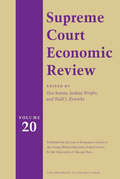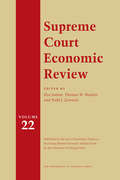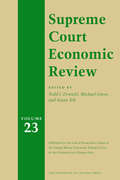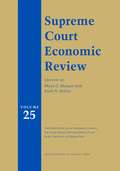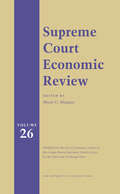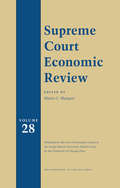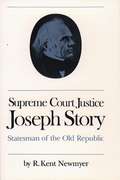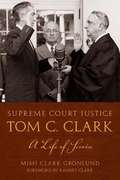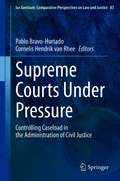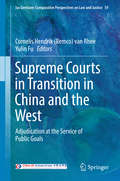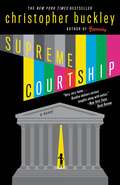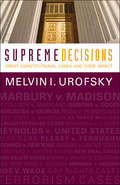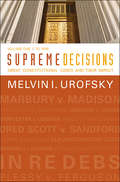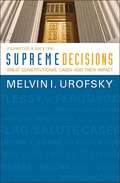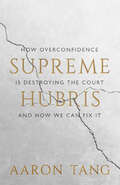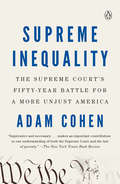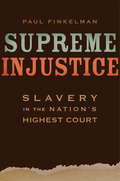- Table View
- List View
Supreme Court Economic Review, Volume 20 (Supreme Court Economic Review #20)
by The University of Chicago PressThe Supreme Court Economic Review is an interdisciplinary journal that seeks to provide a forum for scholarship in law and economics, public choice, and constitutional political economy. Its approach is broad ranging, and contributions employ explicit or implicit economic reasoning for the analysis of legal issues, with special attention to Supreme Court decisions, judicial process, and institutional design.
Supreme Court Economic Review, Volume 22
by Michael S. Greve Todd J. Zywicki Thomas W. HazlettSupreme Court Economic Review is an interdisciplinary journal that seeks to provide a forum for scholarship in law and economics, public choice, and constitutional political economy. Its approach is broad ranging and contributions employ explicit or implicit economic reasoning for the analysis of legal issues, with special attention to Supreme Court decisions, judicial process, and institutional design.
Supreme Court Economic Review, Volume 22 (Supreme Court Economic Review #22)
by The University of Chicago PressSupreme Court Economic Review is an interdisciplinary journal that seeks to provide a forum for scholarship in law and economics, public choice, and constitutional political economy. Its approach is broad ranging and contributions employ explicit or implicit economic reasoning for the analysis of legal issues, with special attention to Supreme Court decisions, judicial process, and institutional design.
Supreme Court Economic Review, Volume 23 (Supreme Court Economic Review #23)
by The University of Chicago PressSupreme Court Economic Review is a faculty-edited, peer-reviewed, interdisciplinary series that applies world class economic and legal scholarship to the work of the Supreme Court of the United States. Contributions typically provide an economic analysis of the events that generated the Court's cases, its functioning as an organization, the reasoning the Court employs in reaching its decisions, and the societal impact of these verdicts. Beyond academic analysis, SCER contributors stimulate interest in the economic dimension of the Supreme Court and explore solutions for its manifold and complex problems.
Supreme Court Economic Review, Volume 24 (Supreme Court Economic Review #24)
by The University of Chicago PressThe Supreme Court Economic Review is a faculty-edited, peer-reviewed, interdisciplinary law and economics series with a particular focus on economic and social science analysis of judicial decision making, institutional analysis of law and legal structures, political economy and public choice issues regarding courts and other decision-makers, and the relationship between legal and political institutions and the institutions of a free society governed by constitutions and the rule of law. Contributors include renowned legal scholars, economists, and policy-makers, and consistently ranks among the most influential journals of law and economics.
Supreme Court Economic Review, Volume 25 (Supreme Court Economic Review #25)
by The University of Chicago PressThe Supreme Court Economic Review is a faculty-edited, peer-reviewed, interdisciplinary law and economics series with a particular focus on economic and social science analysis of judicial decision making, institutional analysis of law and legal structures, political economy and public choice issues regarding courts and other decision-makers, and the relationship between legal and political institutions and the institutions of a free society governed by constitutions and the rule of law. Contributors include renowned legal scholars, economists, and policy-makers, and consistently ranks among the most influential journals of law and economics.
Supreme Court Economic Review, Volume 26 (Supreme Court Economic Review #26)
by The University of Chicago PressThe Supreme Court Economic Review (SCER) is a faculty-edited, peer-reviewed, interdisciplinary law and economics series. The journal has a particular focus on economic and social science analysis of judicial decision-making, institutional analysis of law and legal structures, political economy and public choice issues regarding courts and other decision-makers, and the relationship between legal and political institutions and the institutions of a free society governed by constitutions and the rule of law. The series also publishes special symposium issues that build on SCER's traditional focus on the intersection between law and economics. The contributors include renowned legal scholars, economists, and policy-makers, and consistently ranks among the most influential journals of law and economics.
Supreme Court Economic Review, Volume 27 (Supreme Court Economic Review #27)
by The University of Chicago PressThe Supreme Court Economic Review (SCER) is a faculty-edited, peer-reviewed, interdisciplinary law and economics series. The journal has a particular focus on economic and social science analysis of judicial decision-making, institutional analysis of law and legal structures, political economy and public choice issues regarding courts and other decision-makers, and the relationship between legal and political institutions and the institutions of a free society governed by constitutions and the rule of law. The series also publishes special symposium issues that build on SCER's traditional focus on the intersection between law and economics. The contributors include renowned legal scholars, economists, and policy-makers, and consistently ranks among the most influential journals of law and economics.
Supreme Court Justice Joseph Story
by R. Kent NewmyerThe primary founder and guiding spirit of the Harvard Law School and the most prolific publicist of the nineteenth century, Story served as a member of the U.S. Supreme Court from 1811 to 1845. His attitudes and goals as lawyer, politician, judge, and legal educator were founded on the republican values generated by the American Revolution. Story's greatest objective was to fashion a national jurisprudence that would carry the American people into the modern age without losing those values.
Supreme Court Justice Tom C. Clark
by Mimi Clark GronlundAn associate justice on the renowned Warren Court whose landmark ruling in Brown v. Board of Education overturned racial segregation in schools and other public facilities, Tom C. Clark was a crusader for justice throughout his long legal career. Among many tributes Clark received, Supreme Court Chief Justice Warren Burger opined that "no man in the past thirty years has contributed more to the improvement of justice than Tom Clark. " Supreme Court Justice Tom C. Clark is the first biography of this important American jurist. Written by his daughter, Mimi Clark Gronlund, and based on interviews with many of Clark's judicial associates, friends, and family, as well as archival research, it offers a well-rounded portrait of a lawyer and judge who dealt with issues that remain in contention today--civil rights, the rights of the accused, school prayer, and censorship/pornography, among them. Gronlund explores the factors in her father's upbringing and education that helped form his judicial philosophy, then describes how that philosophy shaped his decisions on key issues and cases, including the internment of Japanese Americans during World War II, the investigation of war fraud, the Truman administration's loyalty program (an anti-communist effort), the Brown decision, Mapp v. Ohio (protections against unreasonable search and seizure), and Abington v. Schempp (which overturned a state law that required reading from the Bible each day in public schools).
Supreme Courts Under Pressure: Controlling Caseload in the Administration of Civil Justice (Ius Gentium: Comparative Perspectives on Law and Justice #83)
by Cornelis Hendrik van Rhee Pablo Bravo-HurtadoThis book discusses civil litigation at the supreme courts of nine jurisdictions – Argentina, Austria, Croatia, England and Wales, France, Germany, Italy, Spain and the United States – and focuses on the available instruments used to keep the caseload of these courts within acceptable limits. Such instruments are necessary in order to allow supreme courts to fulfil their main duties, that is, the administration of justice in individual cases (private function) and providing for the uniformity and development of the law within their respective jurisdictions (public function). If the number of cases at the supreme court level is too high, the result is undue delays, which are mainly problematic with regard to the private function. It may also put the quality of the court’s judgments under pressure, which can affect its public and private function alike. Thus, measures aimed at avoiding excessive caseloads need to take both functions into account. Increasing the capacity of the court to handle larger numbers of cases may result in the court being unable to adequately fulfil its public function, since large numbers of court decisions make it difficult to guarantee the uniformity of the law and its development. Therefore, a balanced approach is needed to safeguard capacity and quality. As shown by the contributions gathered here, the nature of reform in this area is not the same everywhere. There are a variety of reasons for this heterogeneity, ranging from different understandings of the caseload problem itself, local conceptions regarding the purpose of the Supreme Court, and strong entitlements concerning the right to appeal to budgetary restrictions and extremely rigid legislation. The book also shows that the implementation of similar solutions to case overload, such as access filters, may have different effects in different jurisdictions. The conclusion might well be that the problem of overburdened courts is multifactorial and context-dependent, and that easy, one-size-fits-all solutions are hard to find and perhaps even harder to implement.
Supreme Courts in Transition in China and the West
by Cornelis Hendrik Remco Rhee Yulin FuThis edited volume looks at supreme courts in China and the West. It examines the differences and similarities between the Supreme People's Court of Mainland China and those that follow Western models. It also offers a comparative study of a selection of supreme courts in Europe and Latin America. The contributors argue that the Supreme Courts should give guidance to the development of the law and provide legal unity. For China, the Chinese author argues, that therefore there should be more emphasis on the procedure for reopening cases. The chapters on Western-style supreme courts argue that there should be adequate access filters; the procedure of reopening cases is considered to be problematic from the perspective of the finality of the administration of justice. In addition, the authors discuss measures that allow supreme courts in both regions to deal with their existing caseload, to reduce this caseload, and to avoid divergences in the case law of the supreme court. This volume offers ideas that will help supreme courts in both the East and the West to remove unmanageable caseloads. As a result, these courts will be better able to assist in the interpretation and clarification of the law, to provide for legal unity, and to give guidance to the development of the law.
Supreme Courtship
by Christopher BuckleyPresident of the United States Donald Vanderdamp is having a hell of a time getting his nominees appointed to the Supreme Court. After one nominee is rejected for insufficiently appreciating To Kill A Mockingbird, the president chooses someone so beloved by voters that the Senate won't have the guts to reject her -- Judge Pepper Cartwright, the star of the nation's most popular reality show, Courtroom Six. Will Pepper, a straight-talking Texan, survive a confirmation battle in the Senate? Will becoming one of the most powerful women in the world ruin her love life? And even if she can make it to the Supreme Court, how will she get along with her eight highly skeptical colleagues, including a floundering Chief Justice who, after legalizing gay marriage, learns that his wife has left him for another woman. Soon, Pepper finds herself in the middle of a constitutional crisis, a presidential reelection campaign that the president is determined to lose, and oral arguments of a romantic nature. Supreme Courtship is another classic Christopher Buckley comedy about the Washington institutions most deserving of ridicule.
Supreme Decisions (Combined Volume): Great Constitutional Cases and Their Impace
by Melvin I. UrofskySupreme Decisions: Great Constitutional Cases and Their Impact covers twenty-three Supreme Court cases that have shaped American constitutional law. Interpretive chapters shed light on the nuances of each case, the individuals involved, and the social, political, and cultural context at that particular moment in history. Discussing cases from nearly every decade in a two-hundred-year span, Melvin I. Urofsky expounds on the political climate of the United States from the country’s infancy through the new millennium. Featuring Marbury v. Madison, Dred Scott v. Sandford, Miranda v. Arizona, Brown v. Board of Education, and many more, this text covers foundational rulings and more recent decisions. Written with students in mind, Melvin I. Urofsky’s voice offers compelling and fascinating accounts of American legal milestones.
Supreme Decisions, Combined Volume
by Melvin I. UrofskySupreme Decisions: Great Constitutional Cases and Their Impact covers twenty-three Supreme Court cases that have shaped American constitutional law. Interpretive chapters shed light on the nuances of each case, the individuals involved, and the social, political, and cultural context at that particular moment in history. Discussing cases from nearly every decade in a two-hundred-year span, Melvin I. Urofsky expounds on the political climate of the United States from the country's infancy through the new millennium. Featuring Marbury v. Madison, Dred Scott v. Sandford, Miranda v. Arizona, Brown v. Board of Education, and many more, this text covers foundational rulings and more recent decisions. Written with students in mind, Melvin I. Urofsky's voice offers compelling and fascinating accounts of American legal milestones.Supreme Decisions can be purchased as a single combined volume or conveniently split into two volumes, providing a breadth of information for survey courses in U.S. Constitutional History.
Supreme Decisions, Combined Volume
by Melvin I. UrofskySupreme Decisions: Great Constitutional Cases and Their Impact, Volumes 1 and 2, covers twenty-four Supreme Court cases (twelve per volume) that have shaped American constitutional law. Interpretive chapters shed light on the nuances of each case, the individuals involved, and the social, political, and cultural context at that particular moment in history. Discussing cases from nearly every decade in a two-hundred-year span, Melvin I. Urofsky expounds on the political climate of the United States from the country's infancy through the new millennium. Featuring Marbury v. Madison, Dred Scott v. Sandford, Miranda v. Arizona, Brown v. Board of Education, and many more, this text covers foundational rulings and more recent decisions. Written with students in mind, Melvin I. Urofsky's voice offers compelling and fascinating accounts of American legal milestones. Supreme Decisions can be purchased as a single combined volume or conveniently split into two volumes, providing a breadth of information for survey courses in U. S. Constitutional History.
Supreme Decisions, Volume 1
by Melvin I. UrofskySupreme Decisions: Great Constitutional Cases and Their Impact, Volumes 1 and 2, covers twenty-four Supreme Court cases (twelve per volume) that have shaped American constitutional law. Interpretive chapters shed light on the nuances of each case, the individuals involved, and the social, political, and cultural context at that particular moment in history. Discussing cases from nearly every decade in a two-hundred-year span, Melvin I. Urofsky expounds on the political climate of the United States from the country's infancy through the new millennium. Featuring Marbury v. Madison, Dred Scott v. Sandford, Miranda v. Arizona, Brown v. Board of Education, and many more, this text covers foundational rulings and more recent decisions. Written with students in mind, Melvin I. Urofsky's voice offers compelling and fascinating accounts of American legal milestones. Supreme Decisions can be purchased as a single combined volume or conveniently split into two volumes, providing a breadth of information for survey courses in U. S. Constitutional History.
Supreme Decisions, Volume 1
by Melvin I. UrofskySupreme Decisions: Great Constitutional Cases and Their Impact, Volumes 1 and 2, covers twenty-four Supreme Court cases (twelve per volume) that have shaped American constitutional law. Interpretive chapters shed light on the nuances of each case, the individuals involved, and the social, political, and cultural context at that particular moment in history. Discussing cases from nearly every decade in a two-hundred-year span, Melvin I. Urofsky expounds on the political climate of the United States from the country's infancy through the new millennium. Featuring Marbury v. Madison, Dred Scott v. Sandford, Miranda v. Arizona, Brown v. Board of Education, and many more, this text covers foundational rulings and more recent decisions. Written with students in mind, Melvin I. Urofsky's voice offers compelling and fascinating accounts of American legal milestones.Supreme Decisions can be purchased as a single combined volume or conveniently split into two volumes, providing a breadth of information for survey courses in U.S. Constitutional History.
Supreme Decisions, Volume 1: Great Constitutional Cases and Their Impact
by Melvin I. UrofskySupreme Decisions: Great Constitutional Cases and Their Impact covers twenty-three Supreme Court cases that have shaped American constitutional law. Interpretive chapters shed light on the nuances of each case, the individuals involved, and the social, political, and cultural context at that particular moment in history. Discussing cases from nearly every decade in a two-hundred-year span, Melvin I. Urofsky expounds on the political climate of the United States from the country’s infancy through the new millennium. Featuring Marbury v. Madison, Dred Scott v. Sandford, Miranda v. Arizona, Brown v. Board of Education, and many more, this text covers foundational rulings and more recent decisions. Written with students in mind, Melvin I. Urofsky’s voice offers compelling and fascinating accounts of American legal milestones.
Supreme Decisions, Volume 2
by Melvin I. UrofskySupreme Decisions: Great Constitutional Cases and Their Impact, Volumes 1 and 2, covers twenty-four Supreme Court cases (twelve per volume) that have shaped American constitutional law. Interpretive chapters shed light on the nuances of each case, the individuals involved, and the social, political, and cultural context at that particular moment in history. Discussing cases from nearly every decade in a two-hundred-year span, Melvin I. Urofsky expounds on the political climate of the United States from the country's infancy through the new millennium. Featuring Marbury v. Madison, Dred Scott v. Sandford, Miranda v. Arizona, Brown v. Board of Education, and many more, this text covers foundational rulings and more recent decisions. Written with students in mind, Melvin I. Urofsky's voice offers compelling and fascinating accounts of American legal milestones.Supreme Decisions can be purchased as a single combined volume or conveniently split into two volumes, providing a breadth of information for survey courses in U.S. Constitutional History.
Supreme Decisions, Volume 2
by Melvin I. UrofskySupreme Decisions: Great Constitutional Cases and Their Impact, Volumes 1 and 2, covers twenty-four Supreme Court cases (twelve per volume) that have shaped American constitutional law. Interpretive chapters shed light on the nuances of each case, the individuals involved, and the social, political, and cultural context at that particular moment in history. Discussing cases from nearly every decade in a two-hundred-year span, Melvin I. Urofsky expounds on the political climate of the United States from the country's infancy through the new millennium. Featuring Marbury v. Madison, Dred Scott v. Sandford, Miranda v. Arizona, Brown v. Board of Education, and many more, this text covers foundational rulings and more recent decisions. Written with students in mind, Melvin I. Urofsky's voice offers compelling and fascinating accounts of American legal milestones. Supreme Decisions can be purchased as a single combined volume or conveniently split into two volumes, providing a breadth of information for survey courses in U. S. Constitutional History.
Supreme Decisions, Volume 2: Great Constitutional Cases and Their Impact
by Melvin I. UrofskySupreme Decisions: Great Constitutional Cases and Their Impact covers twenty-three Supreme Court cases that have shaped American constitutional law. Interpretive chapters shed light on the nuances of each case, the individuals involved, and the social, political, and cultural context at that particular moment in history. Discussing cases from nearly every decade in a two-hundred-year span, Melvin I. Urofsky expounds on the political climate of the United States from the country’s infancy through the new millennium. Featuring Marbury v. Madison, Dred Scott v. Sandford, Miranda v. Arizona, Brown v. Board of Education, and many more, this text covers foundational rulings and more recent decisions. Written with students in mind, Melvin I. Urofsky’s voice offers compelling and fascinating accounts of American legal milestones.
Supreme Hubris: How Overconfidence Is Destroying the Court—and How We Can Fix It
by Aaron TangHow to repair the dysfunction at the Supreme Court in a way that cuts across partisan ideologies The Supreme Court, once the most respected institution in American government, is now routinely criticized for rendering decisions based on the individual justices’ partisan leanings rather than on a faithful reading of the law. For legal scholar Aaron Tang, however, partisanship is not the Court’s root problem. Overconfidence is. Conservative and liberal justices alike have adopted a tone of uncompromising certainty in their ability to solve society’s problems with just the right lawyerly arguments. The result is a Court that lurches stridently from one case to the next, delegitimizing opposing views and undermining public confidence in itself. To restore the Court’s legitimacy, Tang proposes a different approach to hard cases: one in which the Court acknowledges the arguments and interests on both sides and rules in the way that will do the least harm possible. Examining a surprising number of popular opinions where the Court has applied this approach—ranging from LGBTQ rights to immigration to juvenile justice—Tang shows how the least harm principle can provide a promising and legally grounded framework for the difficult cases that divide our nation.
Supreme Inequality: The Supreme Court's Fifty-Year Battle for a More Unjust America
by Adam CohenA New York Times "20 Books We're Watching For in 2020" pickFrom New York Times bestselling author Adam Cohen, a revelatory examination of the conservative direction of the Supreme Court over the last fifty years since the Nixon administrationIn 1969, newly elected president Richard Nixon launched an assault on the Supreme Court. He appointed four conservative justices in just three years, dismantling its previous liberal majority and setting it on a rightward course that continues to today. Before this drastic upheaval, the Court, led by Chief Justice Earl Warren, had been a powerful force for equality and inclusion, expanding the rights of the poor and racial minorities. Its rulings integrated schools across the South, established the Miranda warning for suspects in police custody, and recognized the principle of one person, one vote. But when Warren retired, Nixon used his four nominations to put a stop to that liberal agenda, and turn the Court into a force for his own views about what kind of nation America should be. In Supreme Inequality, bestselling author Adam Cohen surveys the most significant Supreme Court rulings since the Nixon era and exposes how rarely the Court has veered away from its agenda of promoting inequality. Contrary to what Americans like to believe, the Court does little to protect the rights of the poor and disadvantaged; in fact, it has not been on their side for fifty years. Many of the greatest successes of the Warren Court, in areas such as school desegregation, voting rights, and protecting workers, have been abandoned in favor of rulings that protect corporations and privileged Americans, who tend to be white, wealthy, and powerful. As the nation comes to grips with two new Trump-appointed justices, Cohen proves beyond doubt that the modern Court has been one of the leading forces behind the nation's soaring level of economic inequality, and that an institution revered as a source of fairness has been systematically making America less fair. A triumph of American legal, political, and social history, Supreme Inequality holds to account the highest court in the land, and shows how much damage it has done to America's ideals of equality, democracy, and justice for all.
Supreme Injustice: Slavery in the Nation’s Highest Court (The Nathan I. Huggins lectures #17)
by Paul FinkelmanIn ruling after ruling, the three most important pre–Civil War justices—Marshall, Taney, and Story—upheld slavery. Paul Finkelman establishes an authoritative account of each justice’s proslavery position, the reasoning behind his opposition to black freedom, and the personal incentives that embedded racism ever deeper in American civic life.
